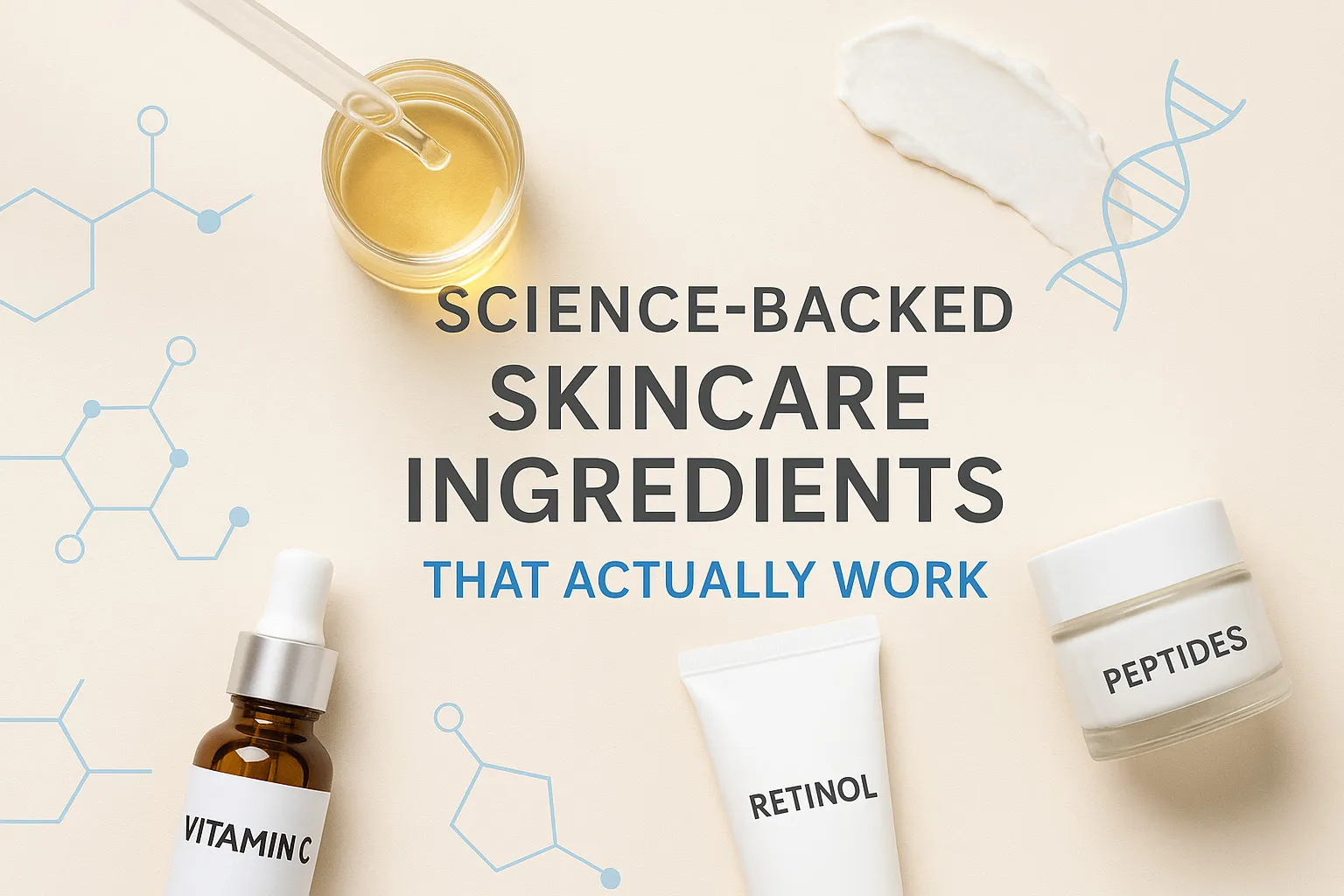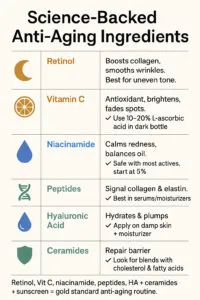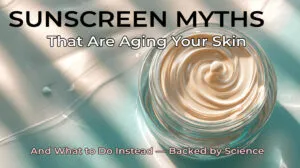The beauty aisle provides a confusing selection of anti-aging skincare products, which include AHA, BHA, C, E, peptides, and retinol, among many others. A handful of science-backed skincare ingredients have proven their effectiveness through extensive research, enhancing skin texture and firmness and creating radiant results. This guide explains the most effective dermatologist-recommended ingredients, detailing their cellular mechanisms and providing safe combination methods for achieving long-term results.
To see how these ingredients fit into a complete anti-aging routine, explore our in-depth guide — The Ultimate Guide to Anti-Aging Skincare.
Science-Backed Skincare Ingredients – Why Science Matters More Than Marketing
The skincare industry makes numerous claims, yet only a small number of ingredients have received proper testing through controlled clinical studies. Dermatologists define evidence-based skincare as ingredients that demonstrate quantifiable benefits for elasticity, hydration, and wrinkle depth during actual scientific testing. You should focus on science-backed skincare ingredients that combat aging factors such as collagen deterioration, oxidative damage, and skin barrier deterioration. The distinction exists between short-term skin radiance and sustained long-term skin wellness.
According to the Harvard Medical School, evidence-based skincare focuses on ingredients proven through peer-reviewed research—not social media trends.
Retinol & Retinoids — The Gold Standard
What it does: Retinoids serve as the fundamental treatment for any anti-aging skincare program. The active ingredient helps cells renew faster, reduces wrinkles and dark spots, and builds collagen.
Why it works: Retinoids derived from vitamin A bind to skin cell receptors, leading to increased collagen and elastin production and faster cell renewal. Studies conducted in clinical settings demonstrate that users achieve noticeable improvements in their skin texture and wrinkle appearance after using retinoids for 12 weeks.
Pro tips:
-
- Begin your retinol treatment with a 0.25–0.5% concentration on two to three nights per week.
-
- Apply the product to dry skin before adding a moisturizing layer on top.
-
- The application of retinoids should be limited to nighttime use because they increase skin sensitivity to UV rays, so users must apply sunscreen daily.

Vitamin C — The Brightening Antioxidant
What it does: The product provides three main benefits: brightening dull skin, creating an even skin tone, and supporting collagen production.
Why it works: The dermatological field has extensively researched Vitamin C (ascorbic acid), which functions as a powerful antioxidant. The antioxidant properties of Vitamin C (ascorbic acid) help fight free radicals that appear from UV exposure and environmental pollution, thus protecting skin from premature aging and loss of firmness.
How to use:
-
- The product should be applied daily after washing your face, before you apply your moisturizer.
-
- The product contains stabilized Vitamin C compounds, including L-ascorbic acid at 10-20% concentration and sodium ascorbyl phosphate derivatives.
-
- You should use sunscreen with SPF 30+ protection when you apply Vitamin C products during the day.
The combination of Vitamin C with sunscreen creates an effective protective system that produces healthy, radiant skin with excellent resilience.
Peptides — The Collagen Signalers
What it does: The structure of peptides consists of amino acids, which function as signaling molecules that trigger collagen and elastin production in skin tissue.
Why it works: Peptides function as natural signals that duplicate the body’s repair mechanisms to stimulate collagen and elastin production in the skin.
The combination of palmitoyl pentapeptide-4 (Matrixyl) and copper peptides functions as a natural repair signal to boost collagen synthesis, which decreases with age.
How to use:
-
- Peptide serums should be applied to the skin following cleansing and before applying thicker moisturizing products.
-
- The product works well with both retinol and niacinamide active ingredients due to its gentle formula.
Peptides function as the essential messengers within your skincare routine because they produce gradual yet significant changes over time.
Niacinamide — The Calm & Balance Molecule
What it does: Niacinamide functions to enhance skin barrier strength while minimizing redness and improving pore appearance.
Why it works: The combination of Niacinamide (vitamin B3) with ceramide and fatty acid production leads to better skin hydration and reduced inflammation. Research demonstrates that using this product regularly will help reduce dark spots and create a smoother appearance of fine lines.
How to use:
-
- You can apply this product during both day and evening routines.
-
- The product mixes well with every other active ingredient in your skincare routine.
-
- The product concentration range for this ingredient spans from 2% to 10%.
Niacinamide is an essential treatment for people with sensitive and combination skin types because it provides balancing properties while performing repair functions.
Ceramides — The Barrier Builders
What it does: Ceramides function to restore natural lipids, which maintain moisture levels and defend against environmental irritants.
Why it works: The outer skin layer contains ceramides, which make up about half of its composition. The skin loses its natural ceramide content when exposed to aging processes, harsh products, and cold temperatures, resulting in dryness and micro-cracks that accelerate aging. The application of ceramides brings back skin smoothness while enhancing its resistance to damage.
How to use:
-
- You’ll find ceramides in “barrier-repair” and “lipid-rich” moisturizer formulations.
-
- People should apply this product every day when they use retinol or exfoliating acids.
-
- Look for products that contain Ceramide NP, Ceramide AP, Ceramide EOP, Cholesterol, and Fatty Acids
A strong barrier system exists as the foundation for maintaining healthy, youthful skin.
Science-Backed Skincare Ingredients – How to Combine Safely
The correct sequence of science-backed skincare ingredients in a smart routine requires the following order:
- Cleanse → water-based serums → actives → moisturizer → SPF (AM).
- You should add new active ingredients to your routine once every two to three weeks.
- You should never use retinol with strong acids during the same nighttime skincare routine.
- Before using the product on your entire face, perform a patch test.
- Active ingredients function optimally when the skin remains hydrated, as balanced skin conditions enable their best performance.
The key to success lies in maintaining a consistent skincare routine rather than using strong products.
Key Takeaways: Build a Results-Driven Routine
-
- Select ingredients that have scientific evidence to support their effectiveness rather than following popular trends.
-
- A complete anti-aging plan requires the combination of retinoids with antioxidants, peptides, and barrier repair agents.
-
- Daily sunscreen application stands as the most potent anti-aging product that exists.
-
- Check your skincare products every 6–12 months because your skin requires different treatments as it matures.
Science-backed skincare isn’t about more products, but uses specific ingredients that work with your body to achieve lasting results.





